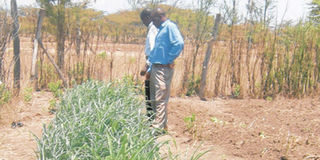From China with new ways to improve crop yields

The technology involves planting the maize in a nursery and then transferring the seedlings to the main field later, like it is done with trees. Photo/JOSEPH KANYI
A new and revolutionary technology, borrowed from China by Ministry of Agriculture officials is being rolled out in the drier parts of Nyeri District and is said to have the capacity to improve food output.
According to Beatrice Theuri, an agribusiness development officer at the ministry’s offices in Nyeri, they learnt of the Maize Transplanting Technology (MTT) from China when they visited the country last year. Now the technology is being tried out in various parts of the district.
The technology involves establishing of a nursery bed and transplanting maize seedlings to the field when they gain three to four leaves.
“The technology aims at increasing yields and reducing time taken in the field,” she says. This is expected to help farmers gain early market for green maize.
The method, probably unique to China is adopted in most of its dry areas as a way of fighting hunger.
And here in the country, a few farmers have been using the technology but now requires upscalling.
Inoculation
Maize is an important food crop for which considerable development is planned in central China.
Most of the land destined for maize culture in this area is where phosphate -deficient acid soils are a major limitation for optimal yields.
Furthermore, farmers in some parts of central China traditionally produce maize plants by first raising maize seedlings in soil blocks and later hand-transplanting them into fields.
This agricultural practice provides an easy, low-cost means to ensure the introduction of selected efficient maize production by inoculation prior to transplanting into the field.
The advantages of transplanting are a reduced mortality compared with direct seeding, scope for the selection of strong and healthy seedlings to ensure a better plant stand and economies in the seed rate.
And since water in the country is becoming a problem, the agribusiness development officer says farmers can water their seedbed once per week.
“There is supplement water at the nursery bed, hence the crop is able to reach maturity even at low rainfall,” says Mrs Theuri. An increase of 30-50 per cent yield production is gained compared with direct seeding with wastage of seeds also being reduced.
Another advantage, says the officer, is that the technology ensures maximum plant population thus avoiding depopulation caused by seed quality and insects.
However, the method has been found to be evidently labour intensive and costly to farmers with huge pieces of land.
A unit nursery of 70 metres provides a number of seedlings sufficient for the transplantation to one hectare.
The seed requirement is of the order of 45 to 55 kg for a unit nursery.
And in order to get healthy and strong seedlings, Mrs Theuri notes that fertilized humus briquettes with a mixture 30:70 (top soil and humus ratio) is put in small poly-bags and maize seeds planted in, then set in a nursery bed.
Alternatively, she says the seeds can be planted direct in the soil at a nursery bed, and then watered at intervals.
According to her, a farmer can either plant one seed or two in the poly-bag depending on their plans.
Maize seedlings are usually grown for up to 25 days in the nursery and then transplanted to the main field.




